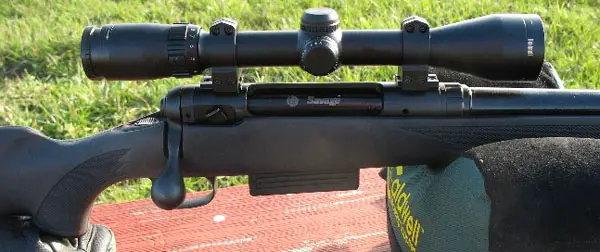|
More Shooting with the Slugging Superstar: By now, my experience with slug guns spans some four decades. As my eight-one years young father likes to remind me, it wasn't all that long ago where the notion of “sighting in” a slug-thrower was being able to hit a plate at 50 yards. Dad also likes to remind me that what I've done, he likely did it first, but that's a story for another day. That was it; back then then was considered as good as it got. If you could do that, it was considered “sighted in” by many. Except for one notable but lamentably short-lived bright spot, the fully-rifled Browning A-Bolt 12 gauge, slug guns as a general class have been sorely lacking. They have been rifles that don't perform like rifles. It has been so bad that I suppose some people don't even consider them “rifles,” but of course they are. If you have rifling in the barrel of a shoulder-fired long gun, obviously you are using a rifle whether that rifle loads from the muzzle, is centerfire, rimfire, or uses Reifenhauser style 20 gauge cartridges. During the Napoleonic wars the British had special rifle units, armed with rifled muskets known as the “Baker Rifle.” The rifle has been with us for a very long time indeed. One thing to consider with 20 gauge slug rounds is that their stated velocities as published on the box are highly unlikely to be much more than wishful thinking. It isn't just one manufacturer, it is all of them and there is a reason for this. The test barrels used for 20 gauge saboted slug rounds are 30 inches long, the industry standard. Yet, you won't easily find a 30 inch barreled factory rifled slug gun. The only way to really know under a specific set of ambient conditions to to chronograph shot strings, as was done for this article. However, if you want a more accurate number than is printed on the box, just subtract 125 fps from the stated velocity of the load. It works out quite well here for the preferred Federal Barnes 1900 fps load, but of course when the specific shell is changed, so is everything else. 22 to 24 inch barreled 20 gauge slug guns appear to be the most popular. There are no clear standards in rate of twist for 20 gauge slug gun barrels, either, ranging from 1:24" to 1:35". It has to be a bit of a challenge for ammo manufacturers to come up with things that work well in all applications, as the 20 gauge shell itself has no precise standards in the sense that metallic cartridges have. Not only can a typical 20 gauge shell be approximately (very approximately) 2-3/4 inch or 3 inch unfolded length, unfolded lengths don't apply to brass. With saboted slugs nested entirely inside the hull, overly generous freebore is a certainty. By now, after four separate range sessions and over five hundred rounds later, there is a lot more that can be said about Savage's 220F. It appeared to be a revolutionary slug gun at first blush for the reasons stated in the original article, but now I'm quite convinced of it. It has shot MOA at both 100 and 150 yards for me, and while the first 200 yard testing resulted in roughly 3-1/2 inch 3-shot groups, the last shooting session produced 200 yard groups inside 3 inches. Of the seven different types of ammo tested, the Federal Premium P209XT1 3 inch loads with the 5/8 oz. Barnes Expander polymer tipped bullets proved to be the best, at least in this individual rifle. Of the rest, the Winchester 260 grain Partition Gold SSP203 loads did quite, but a clear notch back from the Federal Premiums. Inside 100 yards it is unlikely to matter, but the Federal Premiums shot more consistently by a fair amount and the terminal performance of the Barnes Expanders is a known quantity, meaning they have been spectacularly good in my experience. Both Dad and I just used very similar bullets to bag our respective bears in Minnesota just a month and a half ago.  On the board at 100 yards on the most recent day of testing, the first two shots cut the very same hole. One thing you might want to keep in mind is barrel heating. Groups tend to open up with hot barrels, of course, but when plastic sabots are used it is even more important. The more patient I was about letting the barrel cool between shots, the tighter the groups became. I'm fortunate to have my own private shooting area, so it is easy to move targets, shooting benches, or both around as necessary to shoot at any range that seems appropriate, so I chose 150 yards next. I was sighted in about 3-1/2 inches high at 100 yards and managed a really excellent 1.5" group at 150. As a friend of mine likes to say, sometimes I seem to flinch correctly, blind hog finding the acorn and all of that. I'd imagine many shooters will get even better results in their 220F's, once they find the load their individual gun likes to be fed. When I miss, I generally write it off to my keen and otherwise highly developed lack of ability. Time to drag things back and give it a go at 200 yards. The first three shots out of the Savage, aiming dead on at the top target, dropped about 11-12 inches, forming a triangular group that measures just inside 3 inches center to center. In other words, the group went from about 3-1/2 inches high at 100 yards to roughly 7-8 inches below point of aim at 200 yards. This gives me a fairly good idea of what the external ballistics are like out of this rifle with this load. Average velocity, as recorded by the CED Millenium M2 chronograph, is 1745 fps. Many bargain-type consumer chronos tend to read high, some higher and higher the older they get. That's why I went to a pair of CED Milleniums a few years back, and haven't looked back. Sometimes, bad data is taken as better than no data at all. Please see the U.S. Federal “budget” for more details on that one. The 15 foot recorded velocities were 1731, 1755, 1763, 1734 and 1746 fps for an average of 1745.8 feet per second. The Standard Deviation is 12.15. A static Ballistic Coefficient applied to the tipped Barnes Expander of .19 is good enough for government work. Tracing back to the muzzle, correcting the 15 foot intrumental velocity to actual muzzle velocity equates to about 1775 fps. Roll it all together with a 6 inch kill MPBR indicates a true target zero of 141 yards and we get something that approximates a 165 yard PBR. So, essentially it is center of the body hold on a whitetail to 165 yards. You can sight in 3 inches high at 80 yards, or zero at 141 yards which (with a 1.5 inch scope height with a "standard" atmosphere) which is close to the same thing. The short version of all this is to suggest an initial sight-in of 3 inches high at 80 yards, then confirm your POI at 165 yards. For most hunting applications, this very quickly gets you where you need to be with the Federal P209XT1 load. Using a 3 MOA reticle subtension hold point, or something like the 3 in. @ 100 yards line on the etched Bushnell Ballistic reticle on the tested rifle, will take you from 165 yards to right at 195 yards. Like anything else, you are the one that has to determine your own complete confidence level. Like Jack O'Connor repeatedly expounded, the maximum point bank school or range (or top of the shoulder hold as Mr. O'Connor wrote) style of hunting is good hunting. Awareness of ambient conditions (wind), animal stance and animal movement mandates that hunters adjust their maximum shooting distances to closer ranges in concert. To put in your hands such an excellent handling, pleasant shooting little rifle that can easily handle most anything in North America out to 165 yards right out of the box, disguised as slug gun, is something that most everyone can appreciate. I don't think Savage will be able to build the 220F's fast enough and I hope that Federal and Barnes can fill the demand, as well. Savage CEO Ron Coburn confidently made what has to be the understatement of the year, “If you think this is the same old Savage, think again.” As far as the Savage 220F goes, I don't think it can be put any better than that. If you think the 220F is the "same old slug gun," you might want to think again. It is both a bargain and a supremely competent slug firing rifle, the likes of which has never been available before from anything remotely near this price category, or in some respects, at any price. I'm very glad I bought mine and I think you'll be more than glad when you buy yours. If you can hit it, you can eat it. A lot more people are likely to be well-fed this year, courtesy of Savage's new 220F. Update: Thursday, December 3 was the opening day of the late firearms season. I had an open Ford County tag, and my 81 years young father was ready to go hunting. Hunting and finding are two different things, of course, particularly when you have a sea of standing corn still out. But, that's why they call it hunting. Meeting my Dad, I asked Mom what type of deer she wanted. Her reply was, "A tender one." With a gusty chill in the air and a few snow flurries in the air, Dad and I made the trek. With standing crops there isn't much to see in corn and bean land, of course, but if you don't get out there you can be assured of nothing. At about four in the afternoon, with the temperature dropping into the twenties, a couple of does walked straight out of standing corn just over 150 yards away, and stopped. Dad whispered, "What do you think?" The 220F came up and barked off-hand at the at the larger of the two young does, letting loose with a Federal Barnes Tipped as discussed before. The Federal Barnes blew through the doe like butter, taking off the top of the heart. The doe bolted back into the standing corn, dropping dead in about 15 yards.  Above is the result, with the exit wound facing the camera. Mom got her wish, a corn-fed "tender one" that is soon to be fine dining with no preservatives, growth hormones, artificial colors or flavor. A great job by both the Savage 220F and the Federal Barnes load. Slug hunting just doesn't get much better than this. |